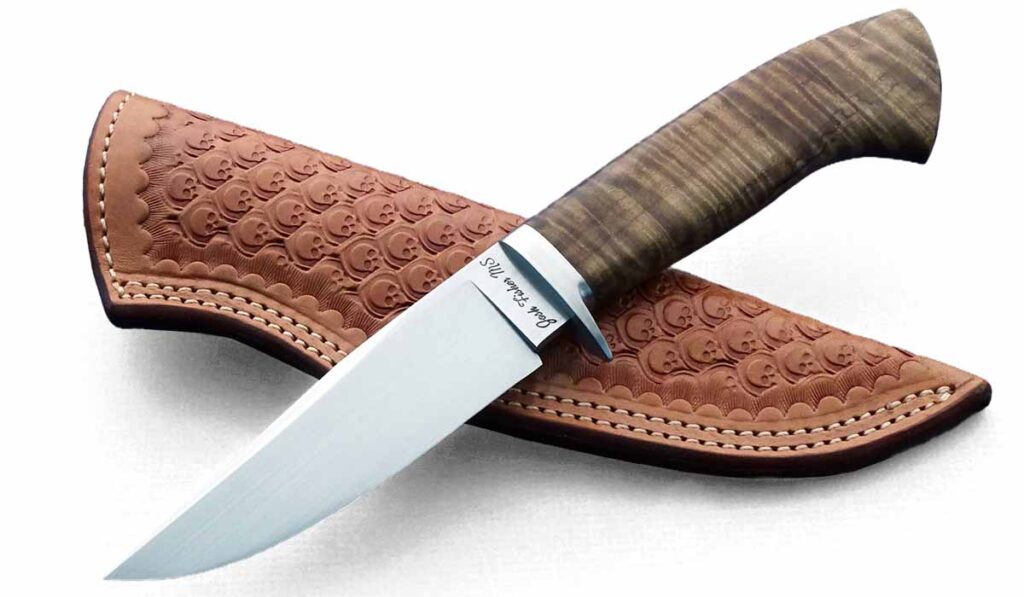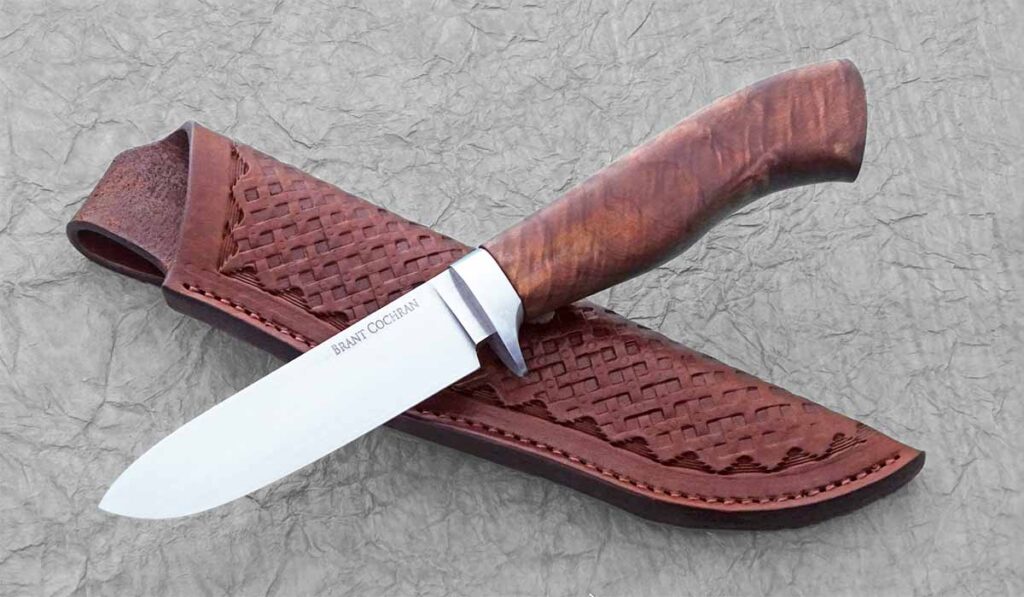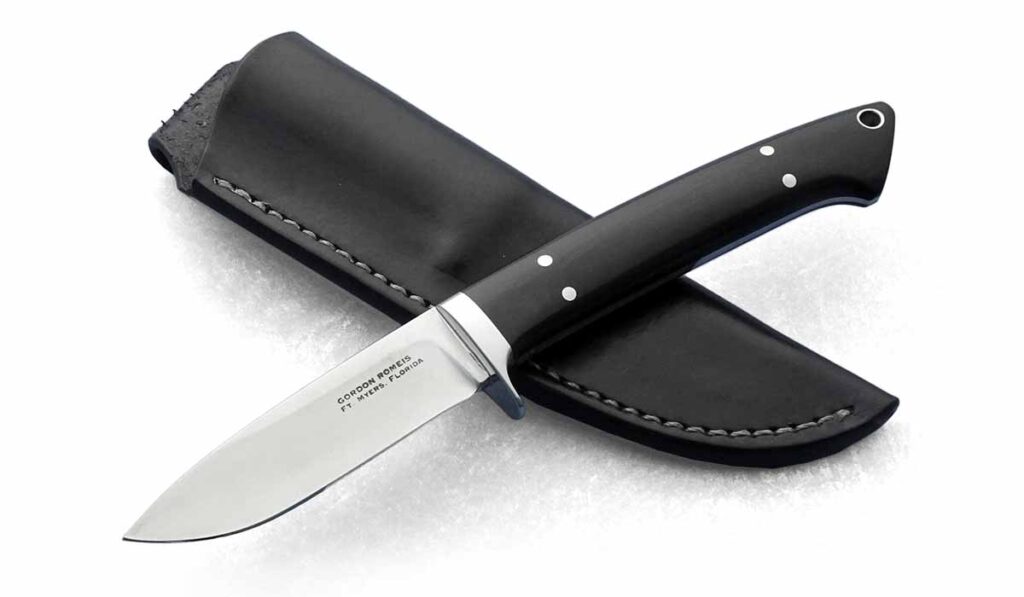
What to look for in a custom hunting knife and some sharp examples.
For outdoorsmen, a knife of some kind is almost a constant companion. Most carry a knife that falls into the category of a hunter.
The Merriam-Webster Dictionary defines hunting knife as a large, stout knife used to skin and process game. When I started judging custom knife competitions at knife shows 30 years ago, the category with the greatest number of entries was always the hunter. Why? Because there are so many interpretations of what a hunting knife is. Often the judges refer to their own experience using knives in the category. Entries generally range in blade length from 2.5 to 5 inches. I have seen knives entered in the category with 10-inch blades.
Blade Lengths
Blade lengths are often designed to process a particular bird or animal. Smaller blades in the 2.5-to-3-inch range are primarily used for dressing birds. The short blade length allows the hunter to quickly extract the bird’s breast meat. The most common blade length is 4 to 4.5 inches, a length that will dress out most game hunted regularly in North America. The dropped hunter/drop-point hunter designed by BLADE Magazine Cutlery Hall-Of-Fame® member Bob Loveless (page 26) is the world’s most copied hunting knife. The standard Loveless drop point features a 4-inch blade.

Nessmuk Skinner
Maker: Luk Kuberski
Blade Length: 4.75”
Blade Steel: Sleipner stainless
Blade Finish: Satin
Blade Style: Drop point
Handle Material: Ash maple burl
Overall Length: 8.6”
Sheath: Leather pouch/belt model by the maker
Author’s Comments: Full-tang construction; excellent balance and handle ergonomics; serrated thumb ramp enhances control
Maker’s price for a similar knife: $350
When dressing out larger game such as moose or elk, many hunters prefer a longer blade because of the animal’s size. Why is the 5-inch blade the limit? The idea behind the hunting knife is to dress out the animal without losing control and cutting into the animal’s vital areas. Going much past a 5-inch blade can affect the average hunter’s ability to control the cutting edge.
Blade Steels
Materials for hunting knife blades are primarily stainless and carbon steels, though damascus has been gaining in popularity in recent years. The environment the hunters will be in and their skill level at resharpening a blade will enter into the choice of steel.

Drop-Point Hunter
Maker: Josh Fisher
Blade Length: 4.5”
Blade Material: 1084 carbon steel
Blade Style: Drop point
Guard Material: Stainless steel
Handle Material: Curly maple
Overall Length: 9”
Sheath: Tooled-leather pouch/belt model in a skull motif by Bob Bobbert
Author’s Comments: Excellent handle ergonomics and balance; Josh is an ABS master smith
Maker’s list price for a similar knife: $625
Each steel has its advantage(s) concerning rust resistance, ease of sharpening and edge holding. Carbon steels such as 1084, 5160 and 52100 provide an extremely keen edge and can be easily resharpened. They do, however, require more corrosion maintenance. Stainless steels such as 440C, ATS-34 and CPM 154 make up the bulk of stainless steels used on custom hunters. These can be reasonably simple to sharpen and more forgiving regarding corrosion.
Whichever steel you choose, the blade should be cleaned after use and a light coat of oil should be applied. It is best not to store your knife long-term in a leather sheath, as the tannic acid found in the leather can rust your blade. Additionally, leather does hold moisture, which can hasten the rusting process of the steel. It is best to store knives in something other than their leather sheaths.
Handle Materials
A wide variety of handle materials are used for hunting knives. A favorite among makers and outdoorsmen is Sambar stag, either in its natural color or dyed to create amber stag. Stag is favored not only for its looks but because its contours provide an excellent gripping surface, even when wet. Another handle material gaining favor is elk and much for the same reasons. Two advantages of elk are it can be found in larger sizes and is less expensive.

Elk Hunter 23
Maker: Mike Malosh
Blade Length: 47/8”
Blade Material: W-2 tool steel
Blade Finish: Satin
Guard Material: Stainless steel
Handle Material: Elk w/black Micarta® and stainless steel spacers
Overall Length: 9.5”
Sheath: Leather pouch/belt model by the maker
Author’s Comments: This knife is built for serious work; excellent balance and handle ergonomics
Maker’s price for a similar knife: $395
Desert ironwood, curly koa, California buckeye burl and curly maple are among various kinds of popular handle woods used for hunters. Other popular materials are synthetics such as G-10 and Micarta®. The main advantage of these materials is that, for the most part, they are impervious to the elements. As such, they tend not to shrink and crack as some natural handle materials can do over time.
Guards
Guards are made primarily from either 304 or 416 stainless steel. If the knife features a hidden tang design, the joint between the guard and the blade should be soldered. Sealing the guard helps keep the moisture away from hidden tangs. Because their softness makes them prone to damage, along with their additional maintenance requirements, brass and nickel silver generally are not used for guards.
Blade Styles
The drop-point hunter is the most commonly made hunting knife. The drop-point blade maintains its thickness along the spine and then gently slopes to the point. Generally, the drop point is slightly thicker than other hunting blade patterns at the point. The blade thickness provides the drop point the versatility not only to skin but to disjoint and pry. These advantages can be critical to the hunter when dressing larger game.

Semi-Skinner
Maker: Brant Cochran
Blade Length: 4.25”
Blade Material: 80CrV2 carbon steel
Blade Finish: Satin
Guard Material: Stainless steel
Handle Material: Walnut
Overall Length: 9”
Sheath: Tooled-leather pouch/belt model by the maker
Author’s Comments: 80CrV2 is a carbon steel that is both tough and provides outstanding edge retention; excellent balance and handle ergonomics; sturdy lightweight knife, perfect for your next hunt; Brant is an ABS journeyman smith
Maker’s price for a similar knife: $300
The idea of a skinner is basically to remove the skin/fur from the game. The skinning blade shape features a slightly thinner blade and edge meant for a specific purpose. The skinner is designed for elongated cuts and better control of the blade, ensuring the game’s fur maintains its integrity. While primarily intended to remove the fur, a knife with a skinner blade can be used to dress game out, too. One of the more popular skinner designs is the Nessmuk, praised for its all-around versatility in the field.
The semi-skinner blade is the middle ground between the drop-point and skinner blades. The slightly raised blade spine/hump extends the curved part of the blade for skinning while maintaining the drop point to avoid puncturing the abdominal cavity, which could taint the meat of the animal.
Conclusion
Picking the right edged companion for your time in the field should require some research. As noted, hunting knives come in various shapes and sizes. This variety enables you to choose the right size, steel and handle material necessary to get the job done. It would benefit you greatly to hold the knife in your hand, primarily for sizing. You must always be able to control the blade’s edge.

Drop-Point Hunter
Maker: George Romeis
Blade Length: 3.5”
Blade Steel: CPM 154 stainless
Blade Finish: Satin
Guard Material: Stainless steel
Handle Material: Black G-10 w/stainless-steel-lined thong hole
Overall Length: 8”
Sheath: Leather pouch/belt model by the maker
Author’s Comments: Full-tapered tang, excellent balance, very comfortable in the hand
Maker’s price for a similar knife: $300
Remember, the rifle or bow harvests the game but the knife creates what becomes dinner and the trophy.
Check Out More Outdoor Knives And Tools:
- Best Bushcraft Knife: When Steel Meets Woods
- Best Camp Knives: Outdoor Do-Alls
- Best Hatchets And Axes For Survival And Camping
- Best Gut Hook Hunting Knives
 NEXT STEP: Download Your Free KNIFE GUIDE Issue of BLADE Magazine
NEXT STEP: Download Your Free KNIFE GUIDE Issue of BLADE Magazine
BLADE’s annual Knife Guide Issue features the newest knives and sharpeners, plus knife and axe reviews, knife sheaths, kit knives and a Knife Industry Directory.Get your FREE digital PDF instant download of the annual Knife Guide. No, really! We will email it to you right now when you subscribe to the BLADE email newsletter.







Soy Retirado de Rescate y Emergencia y un fanático de las navajas y Cuchillos por una experiencia que tuve hace Unos cuantos años y sin navaja no Camino por que se la importancia de una Navaj y quiero aprender mas de las navajas y Cuchillos por que e Creado un programa en P.R de la importancia de Tener una buena Navaja y las Diferentes metales y sus Usos me encanta su Revista